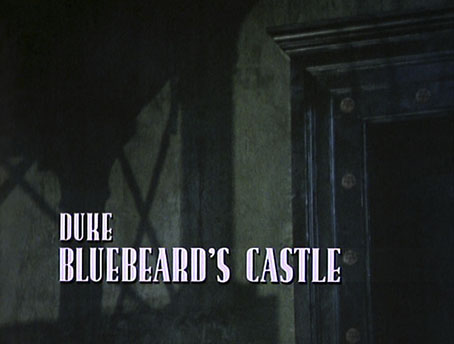
Back in the days when the BBC’s television output challenged its audience rather than pandered to it, Leslie Megahey was a name I always looked out for. During the 1970s and 80s, Megahey was one of the corporation’s outstanding producers and directors, and since his tastes often ran very close to mine seeing his name in a magazine listing was an alert for some essential viewing. Favourite Megahey documentaries would include his Omnibus film about (and interview with) György Ligeti in 1976, and the two-part Arena special about Orson Welles in 1982 that persuaded the director to talk at length for the first time about his career. Megahey’s arts films included drama documentaries about the French painters David and Gericault, and two dramas with painting themes, Cariani and the Courtesans (1987), and Schalcken the Painter (1979), the latter being an exceptional adaptation of the Sheridan Le Fanu ghost story. Duke Bluebeard’s Castle was one of the last of his BBC films, an adaptation of the Bartók opera that had this Bartók obsessive hopping with delight when it was screened in 1988.
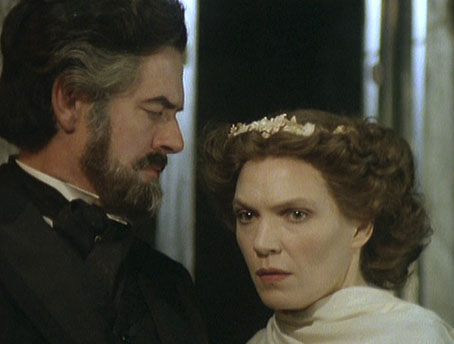
Bluebeard and Judith.
Bartók’s only opera was written in 1911, and is easier to adapt than most, being a single act of an hour or so in length with only two performers, Bluebeard (bass) and Judith (soprano). Given this it’s surprising there haven’t been more filmed versions. I wrote something a while back about the seldom-seen Michael Powell version; then there’s a version from 1981 by Miklos Szinetár scored by the London Philharmonic Orchestra with Georg Solti conducting. Megahey’s film also features the London Philharmonic with Adam Fischer conducting. Robert Lloyd and Elizabeth Laurence are the performers.
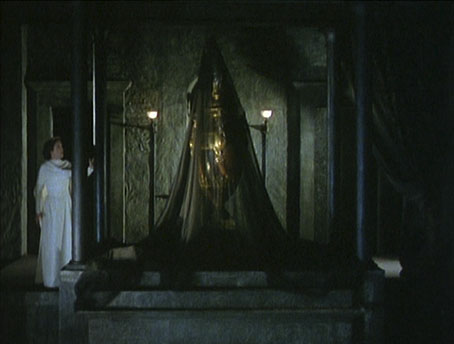
The libretto by Béla Balázs turns the old fairy tale into a psychodrama that’s also one of the first post-Freud operas, with the audience being asked in the prologue “Where is the stage? Is it outside, or inside?” Judith is ushered into the castle by Bluebeard to find seven locked doors: her curiosity and her demands to discover what lies behind the doors (or inside the mind of her husband-to-be) seals her fate. In some of the fairy tale versions the brothers of the bride arrive at the last moment to rescue their sister; not so here.
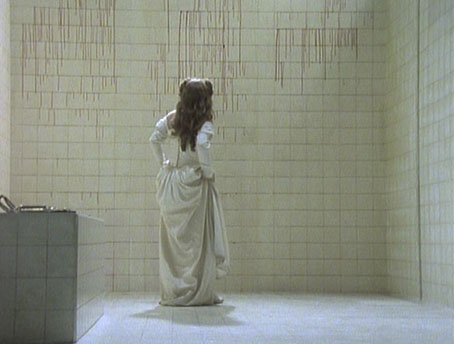
The torture chamber.
Despite the Freudian dimension, Powell and Szinetár’s films still favour the fairy tale antecedents so it’s left to Megahey and his regular production designer Bruce Macadie to try something different. Macadie’s set design blends the decor of 1911 with profoundly Gothic gloom: the castle is a vast, shadow-filled space of Piranesian arches and suspended chains. Gas jets barely illuminate hollows where jet-black statues sit beneath funeral shrouds. The Edwardian dress of the performers not only removes them from the world of fairy tales but contrasts the pair and adds to the sombre atmosphere: Judith is an isolated figure in white wandering through darkness.
In the first room there’s the first of Megahey’s unique touches: the torture chamber is a very 20th-century place, with clean, tiled walls and no sign of its function until the walls begin to bleed. This is not only an apt moment of symbolism but also a clever way of introducing the blood motif that recurs throughout the work.
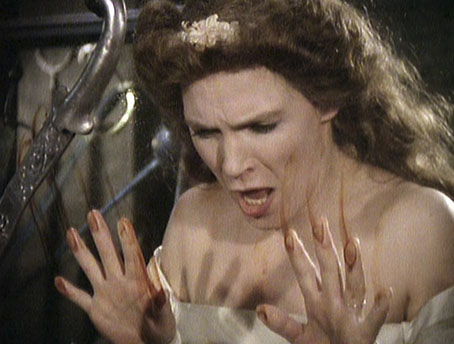
The armoury.
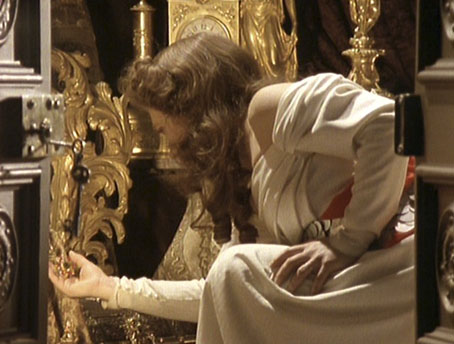
The treasury.
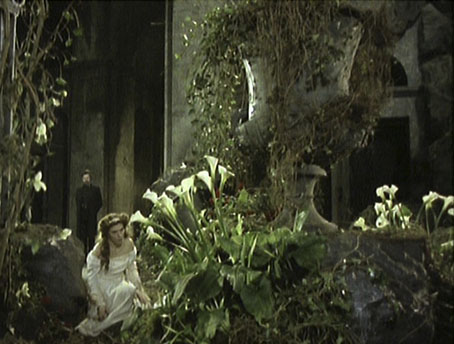
The garden.
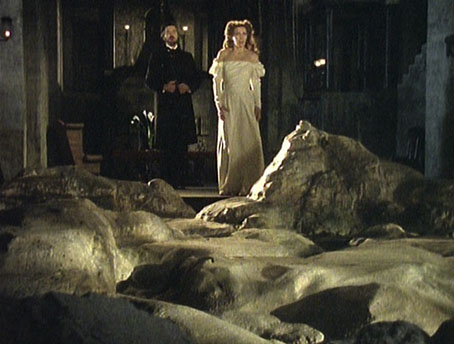
The kingdom.
In the subsequent rooms the blood is found on gore-smeared glass, a necklace of rubies and lilies whose cut stalks bleed in water. The big musical moment in Bartók’s opera comes with the opening of the fifth door which shows in a blaze of light the extent of Bluebeard’s kingdom. Here Megahey creates another unique moment by having the flagstones open and a mist-shrouded miniature landscape rise from the floor. This is a lot more effective than it sounds, and the picture above doesn’t give much idea of the effect.
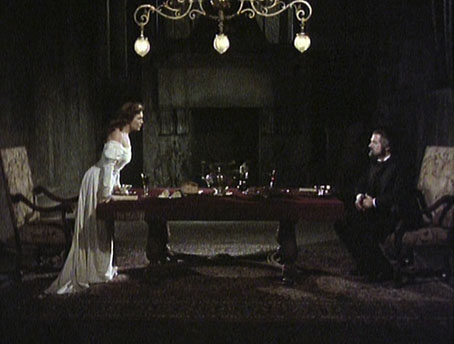
Judith demands the key to the sixth door.
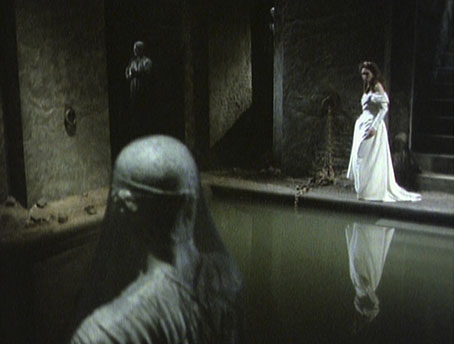
The pool of tears.
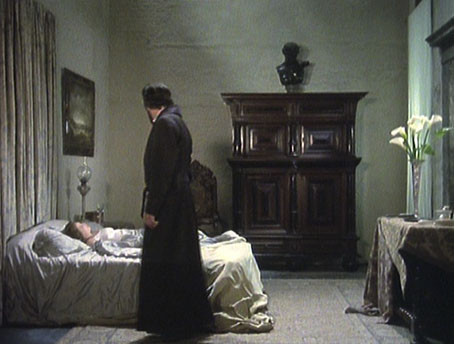
After the pool of tears there’s another directorial interjection as Megahey shows a post-coital scene. The implication is that Judith has given Bluebeard what he wants so she can now demand the key to the final door.
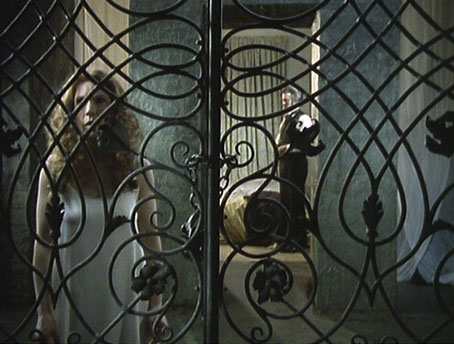
The seventh door.
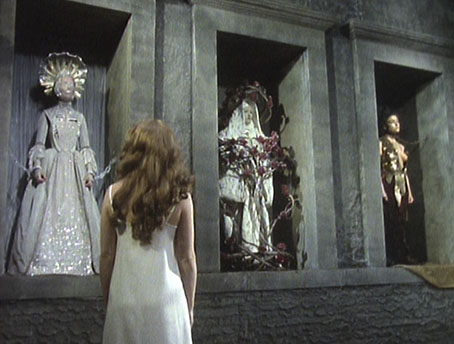
The three wives.
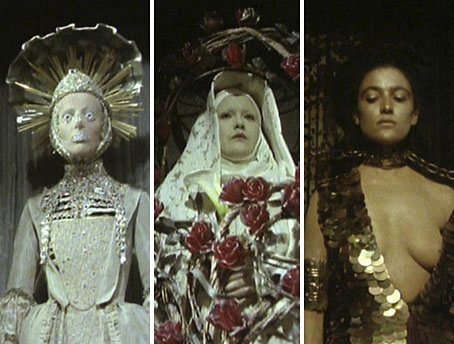
The three former wives which Bluebeard describes as embodiments of morning, noon and evening. Judith takes her place as night in her spangled gown and diamond jewellery.
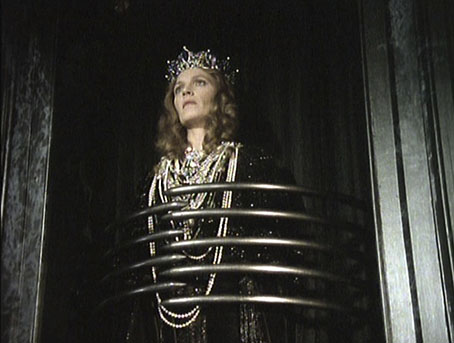
Following Duke Bluebeard’s Castle Megahey wrote and directed The Hour of the Pig (1993), an odd feature film about medieval animal trials starring the now-ubiquitous Colin Firth and the late Nicol Williamson. The US release was chopped about and renamed The Advocate…and that’s been it to date for Leslie Megahey the director. Much of his work, like most of the great TV dramas and documentaries, is out of circulation (TV suffers more than any other medium in this respect) but Bluebeard is an exception, being currently available on DVD in the US from Kultur. The quality is as good as you’d expect from 16mm film, and the sound quality is excellent. It’s also possible to turn the subtitles on or off, something that wasn’t an option during its original screening. For Bartók aficionados it is (that phrase again) essential viewing.
Previously on { feuilleton }
• A playlist for Halloween: Orchestral and electro-acoustic
• Powell’s Bluebeard
• The Tale of Giulietta
• Béla Bartók caricatured

Always happy to see a reference to Leslie Megahey. I wasn’t aware that the Lloyd/Laurence Bluebeard, which I rented on DVD last year (via LoveFilm), was one of his. Maybe that was because, unlike most of the rest of his work, it actually is on DVD. Very fond memories of Schalcken and the David-Ingres-Géricault trilogy; managed to miss Cariani, never to see it repeated. Not so long ago BBC4, for no obvious reason, showed a memorable 1970s drama-doc on Gauguin in Tahiti, with the voice of Leo McKern as the painter: I think that was one of Megahey’s. I remember reading that one reason for his absence from TV and film was that he had spent a long time working with Nicol Williamson on Broadway. (In what capacity I have no idea.)
Klimt reference in the styling of the third wife? upload.wikimedia.org/wikipedia/commons/9/92/Gustav_Klimt_039.jpg
link corrected
I loved Megahey’s Duke Bluebeard’s Castle. Deep psychological insights and ravishing design made it a production to be relished. Perfection.
Not sure if it is available on DVD, but you should try to catch Robert Lepage’s double bill of Schoenberg’s Erwartung and Bartók’s Bluebeard’s Castle. It is an incredible spectacle.
estienne64: I’d forgotten about the Ingres film, which I saw at the time. Thanks for the reminder. The tragedy with these things, like so much television, is they vanish into the archives never to be seen again.
Snoid: Yes, I think you’re right with that, especially when you consider that the painting is of the Biblical Judith. The Bluebeard theme is reversed there since she’s holding the head of Holofernes. I’d also forgotten that the three former wives are indeed morning, noon and evening: the libretto states as much but I’d not looked at that for a while. I’ve amended the post as a result.
michelangelo: I’d love to see what Robert Lepage would do with this!
it looks like a goth fellini remaking a ken russel flick, or russel does tarkovsky with sets by pierre et giles, either way wonderful.
Oh hey, I saw this guy and thought of you, well yr website anyway, I dont know you, http://philippbanken.blogspot.co.nz/ (mabey change the nz to uk Im not sure how these things work)
decadent, beautiful, great line work, got that whole fin de siècle/harry clarke/poe/ vibe so I thought hed fit right in here and I couldnt find a contact link to email it.
Bleeding walls. I wept.
Thanks for the link to Kultur – I just ordered the DVD to replace my poor quality version. Saw a wonderful version of Bluebeard’s Castle at the Opéra Garnier in Paris a few years ago, though spoilt by the terrible sightlines – I could see only a small portion fo the stage.
I remember once drinking a very Dry Martini in my (then) new flat overlooking the Regent’s Canal with a thunderstorm going on and the 5th Door on the turntable. You know – one of those moments.
I’ve never seen Bluebeard live. Nearly saw an orchestral rendition once but we skipped that and went to watch Wild at Heart instead.
There’s something about thunderstorms and music, isn’t there? Every time I hear Richochet by Tangerine Dream I’m reminded of the time I was playing it very loud while the gods were rearranging the furniture overhead.